Triumph and weekdays. How to install the spire on the skyscraper Lakhta Center. Part 2
The installation of the constructive completion of the spire of the Lakhta Center tower resembles a military operation: preparation - waiting - signal - blitzkrieg: lightning-fast conquest by a man of Europe's highest celestial mark.

Installation of the final part of the spire took less than a day. Waiting was delayed for two days. But the preparation ... It started at the dawn of floor-by-floor construction, even before the appearance of giant tower cranes on the shores of the Gulf of Finland.
No wonder the powerful lifting machines Lakhta construction. In this painted as on the notes of the building party they played one of the main roles.
By October 2017 around the skyscraper - a trio of "libherry." Crane "K-4", which worked in the center of the core, has already been disassembled: the core ended at level 88.
Lifting trinity - machines based on the model Liebherr 710HC-L 32/64 - the largest crane with a swinging arm, produced by a global manufacturer. But these cranes are not from the mass conveyor. They were created specifically for the construction of Lakhta Center. Crane "K-3" - for the installation of the final part of the spire construct.
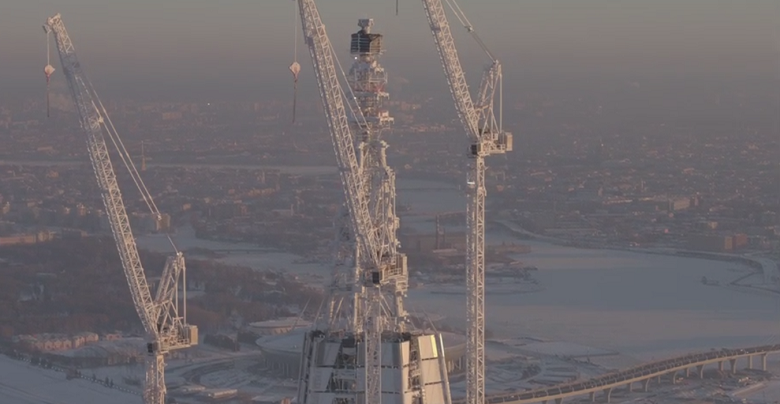
There are two reasons for this: architectural features and microclimatic conditions for the construction of the Lakhta Center tower.
The spire of the tower is steel half-timbered in a metallized shell. Bearing meter pipes-racks and a mass of 2000 tons - inspire, but just for now you do not undertake to compare the scale of the rest of the Supertoll. Each crane attached to the supermassive core of the tower gives a load of 240 tons to the structure! Elastic and light structure of the spire can not cope with this.
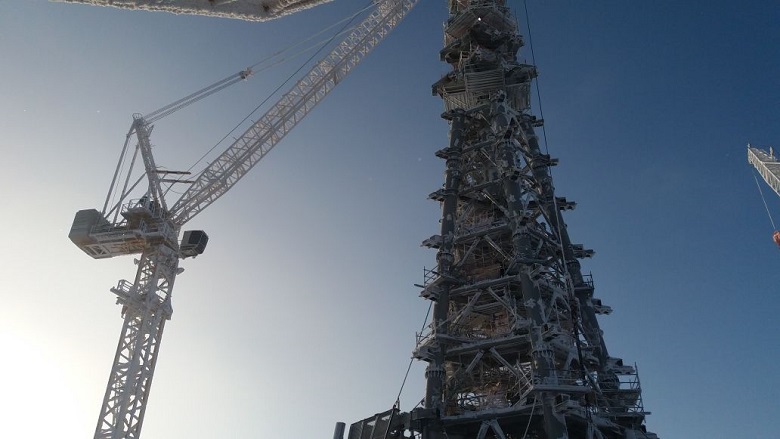
The second important point is the wind. The standard limit for crane operation is 15 m / s. For heights of mass construction, such gusts of wind are not a frequent occurrence, it is possible to build. On the skyscrapers marks - and the wind to match ...
Not surprisingly, the construction in Lakhta has become a real challenge for the manufacturer of lifting equipment. Cranes were designed special - such that they will safely stand even with very strong wind and reach the spire mark.

The last crane attachment to the core of Lakhta Center is at 355 meters.
After this pristezhka at the cranes begins part of the tower, free-standing, composed of reinforced sections. Due to technical solutions, it was possible to resolve the issue with the winds. Estimated wind speed for giant Lakhta cranes - 164 km / h! The highest level of assessment of wind speed on the Beaufort scale! Of course, it is impossible to work with such a hurricane - but the towers will safely stand under the blow of a similar element.
By the end of January, the position of the “senior” libkher, the K-3 lifting machine, approached 450 meters in jib. Ahead is the main challenge, the one for which K-3 was designed even before the start of floor-by-floor construction.
But back to the spire.
The builders assembled most of the tower's spire on the object from steel pipes and connecting beams. The story of the final design is different: she arrived in Lakhta from the factory almost ready-made.
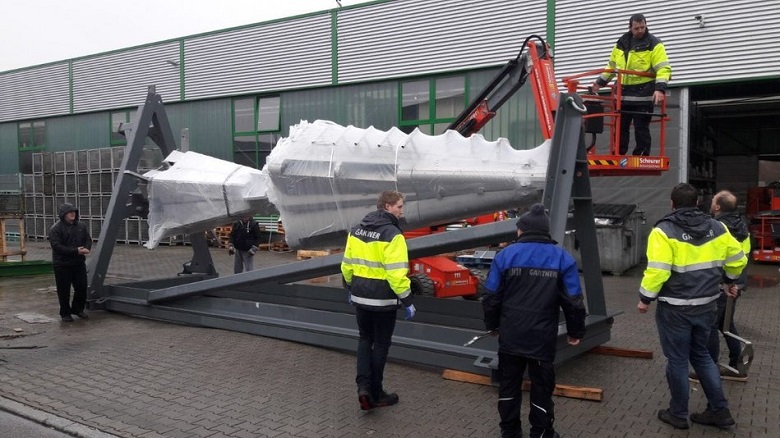
The top design of the spire - tower peak - is a cone of three horizontally separated elements. On the bottom will install later SOF and facade. The tops are already delivered fully assembled: a frame in a stainless steel shell, with straight edges on the outside corners. To the peak of a cone, the faces that run from the bottom of a skyscraper and continue in the architecture of its spire converge at one point. The Lakhta Center Tower twists from the bottom to the top 90 degrees and opens up at this end.

Production of construction at the factory in December 2017-January 2018:

Welding of stainless steel. Upper part of the structural frame Structural

frame

Preparing the structural frame base
Ten holes - for future connection with a supporting ring beam mounted on the central column-tower in the tower at 449 meters.

The base of the peak is the attachment points of the upper and lower parts of the structure. The
finished structure is sent to St. Petersburg, to the Lakhta Center construction site ^
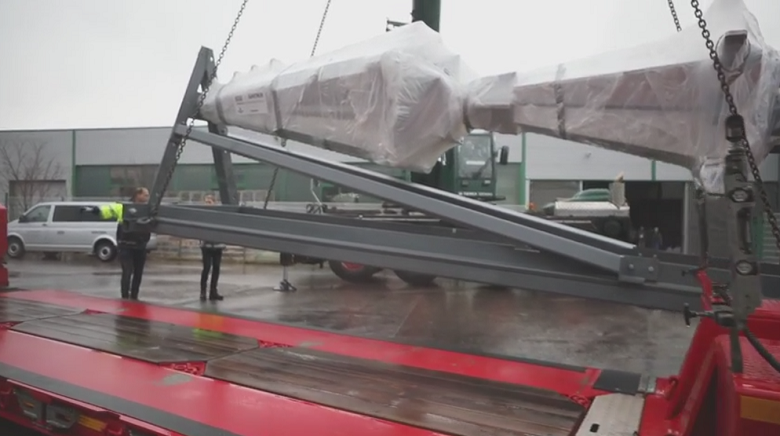

Meanwhile, at the Lakhta Center ... January 2018

The tower peak's future installation site is the central column in the spire of the Lakhta Center tower, 449 meters
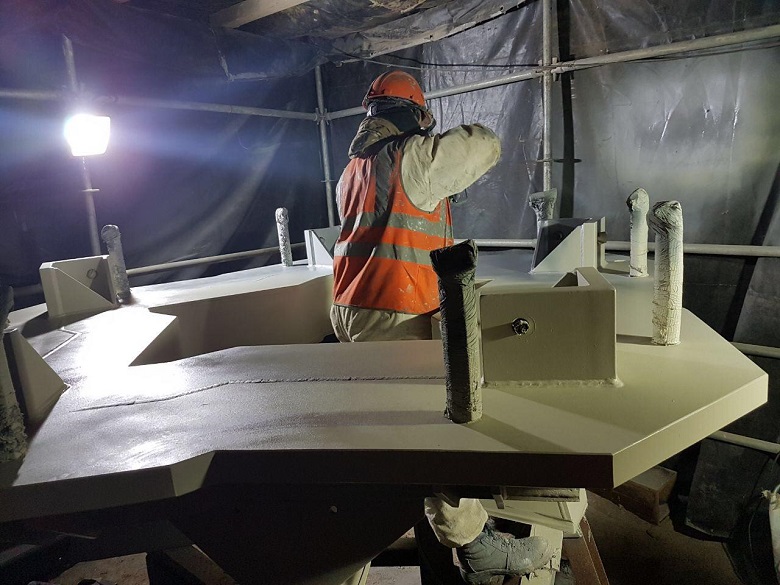
The builder applies fire retardant and paintwork on the supporting ring beam, which subsequently connects the central column in the spire and its peak. Ground operation
The final design of the spire arrives at the construction site
. Everything is ready for the final. But until the triumphant moment will pass two more days.
Builders really need a couple of serene days to bring the crane to the mark, and people - to the peak of the spire. And now - a good forecast: January 28 and 29 - time for high achievements.

Preparing the K3 crane
By the end of January 2018, the giant Libher has already left behind all European supercranes. The bravest London crane operator, who mounted the peak on the Shard skyscraper, and the brave guys who managed to lift the final designs of the towers of Moscow-City - were not at such elevations.
But ahead is the main step up. Right before installation of the final design, the K-3 crane is additionally increased: plus three sections of 5.8 m each and one of 2.85 m stand at the base of its metal tower. The height of the goose-467.3 m! This super step is possible only for a short time - stability with a wind below 100 km / h and work with a wind of no more than 50 km / h.

Superstep crane "K3" The

lower part - the base of the cone spire - in readiness

At the start

First go! Lifting to the installation level at the mark of 449-450 meters. An

annular beam, on which will fix the base of the final design.
After installation, the lower part constructive structure will be surrounded by the facade and complemented by lighting. In the meantime, the task of installers is to quickly install and prepare to receive the peak of the spire.
Early morning January 29, 2018
On the ground

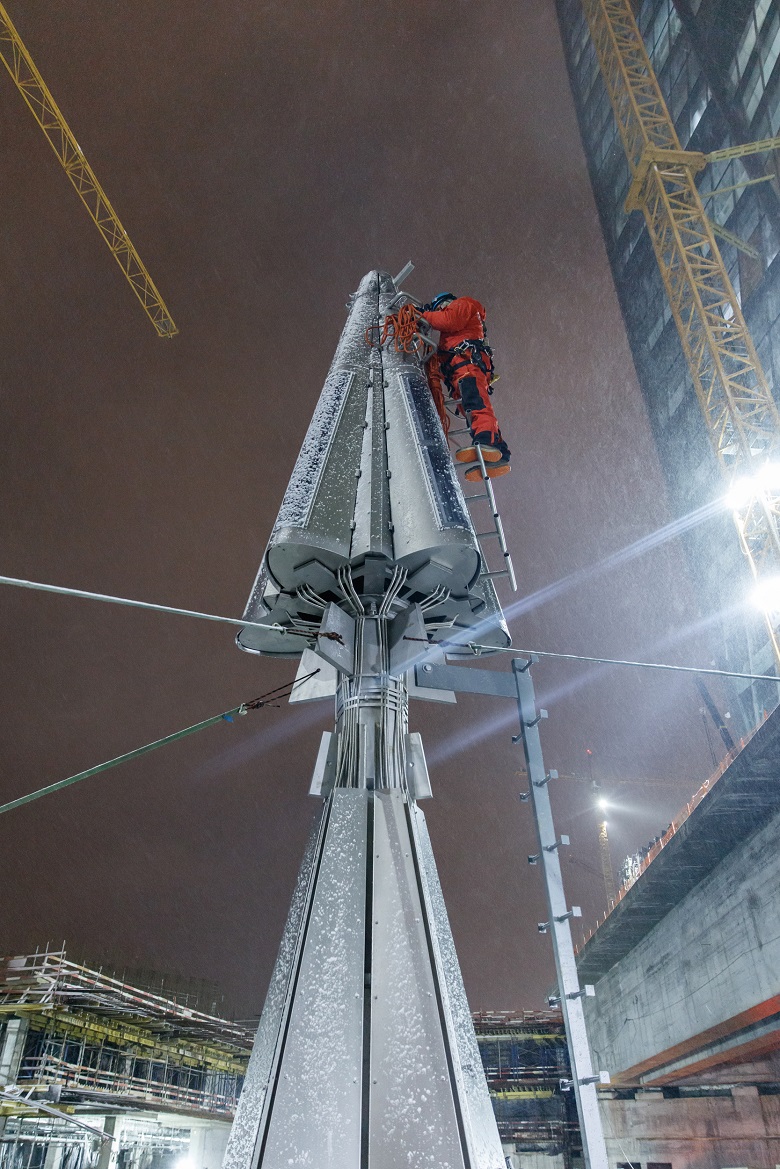
Last design check before sending to the assembly level and installing fixing cables for crane lifting

Still on the ground at the top of the spire are installed lights of light marking, architectural lighting and anti-icing system (heated). Checking all systems
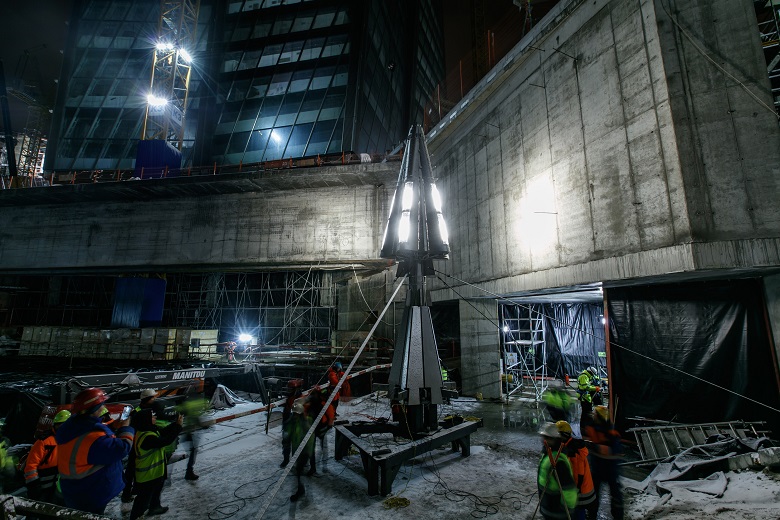

Sling cargo on a crane hook

Lifting gone! Gap - to the applause of the builders

Climb
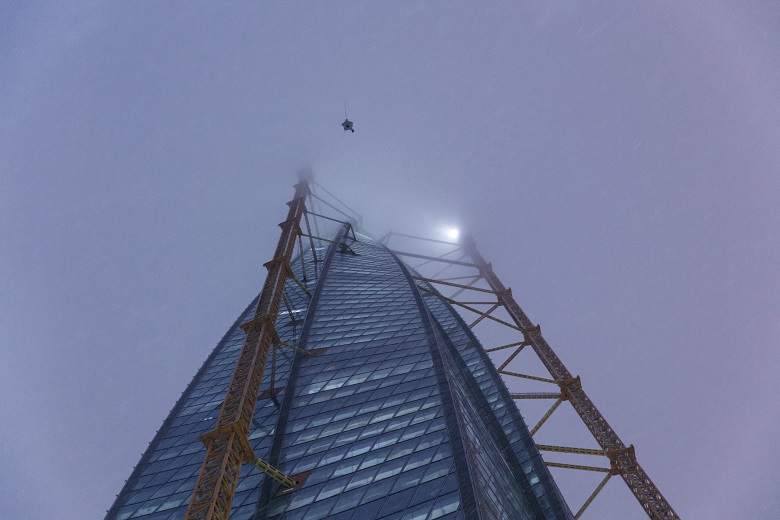
One second before escaping from the ground from the ground.
Docking process:
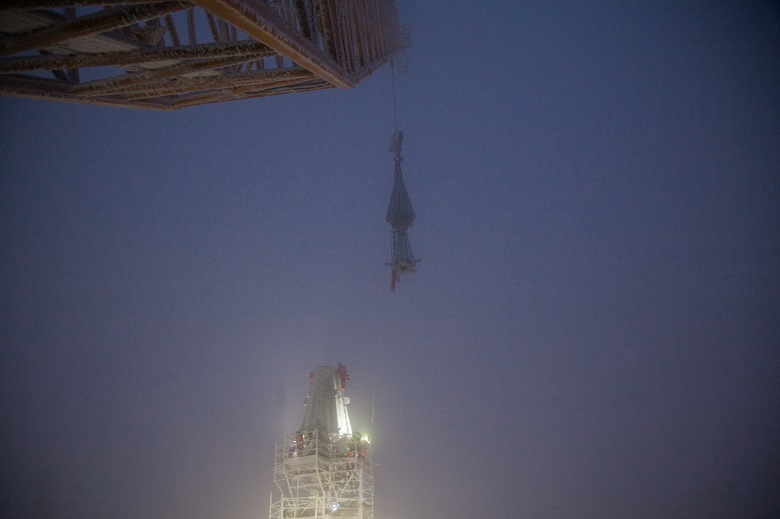
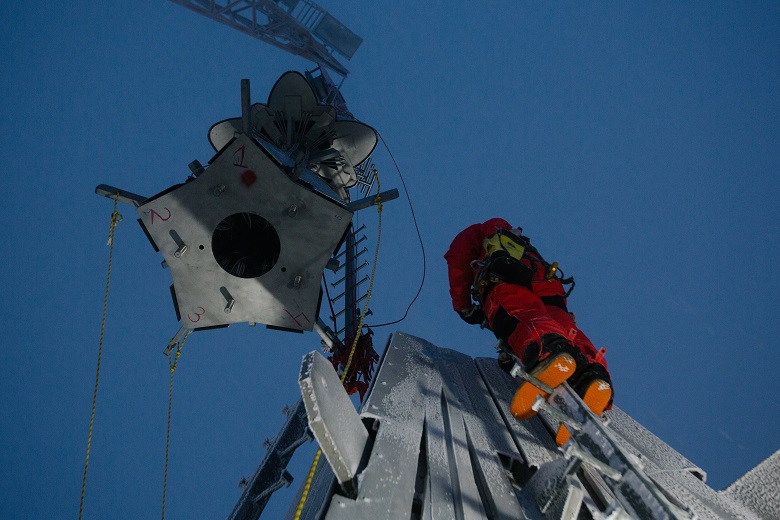
Notice how gently and precisely the crane lowers the load to the mark. This is extremely important for the safety of climbers - in the case of a helicopter, the buildup of a load and a strong outflow to the installers from under the aircraft blades would be inevitable.
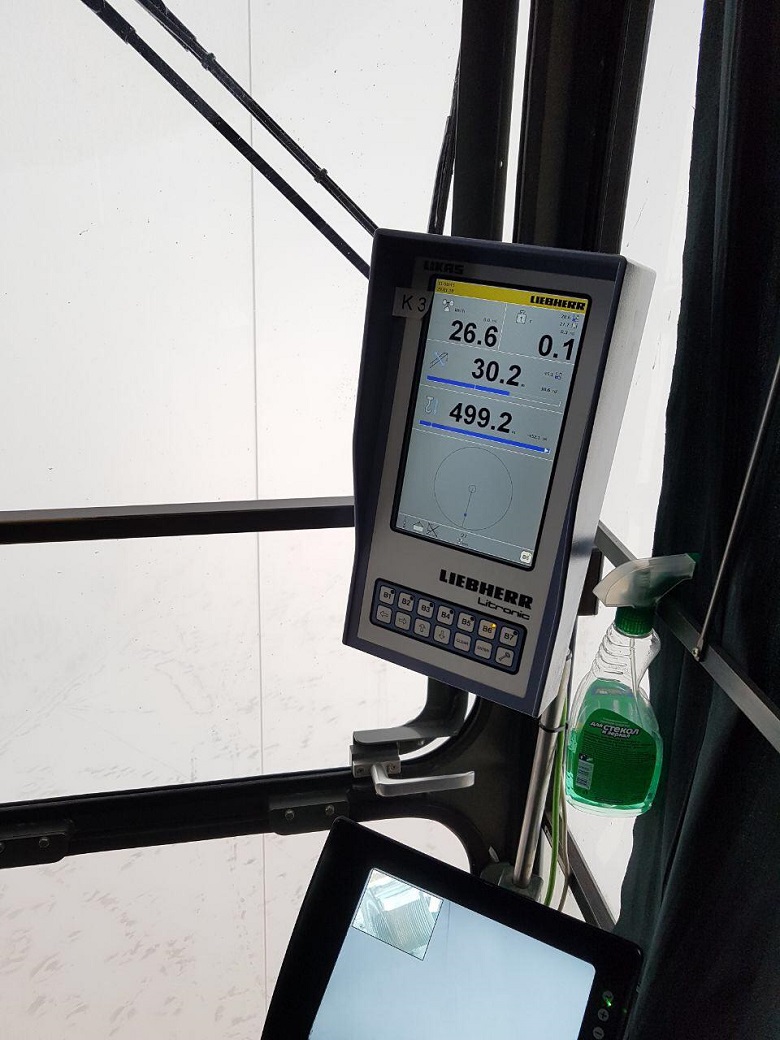
The length of the crane cable is almost half a kilometer!

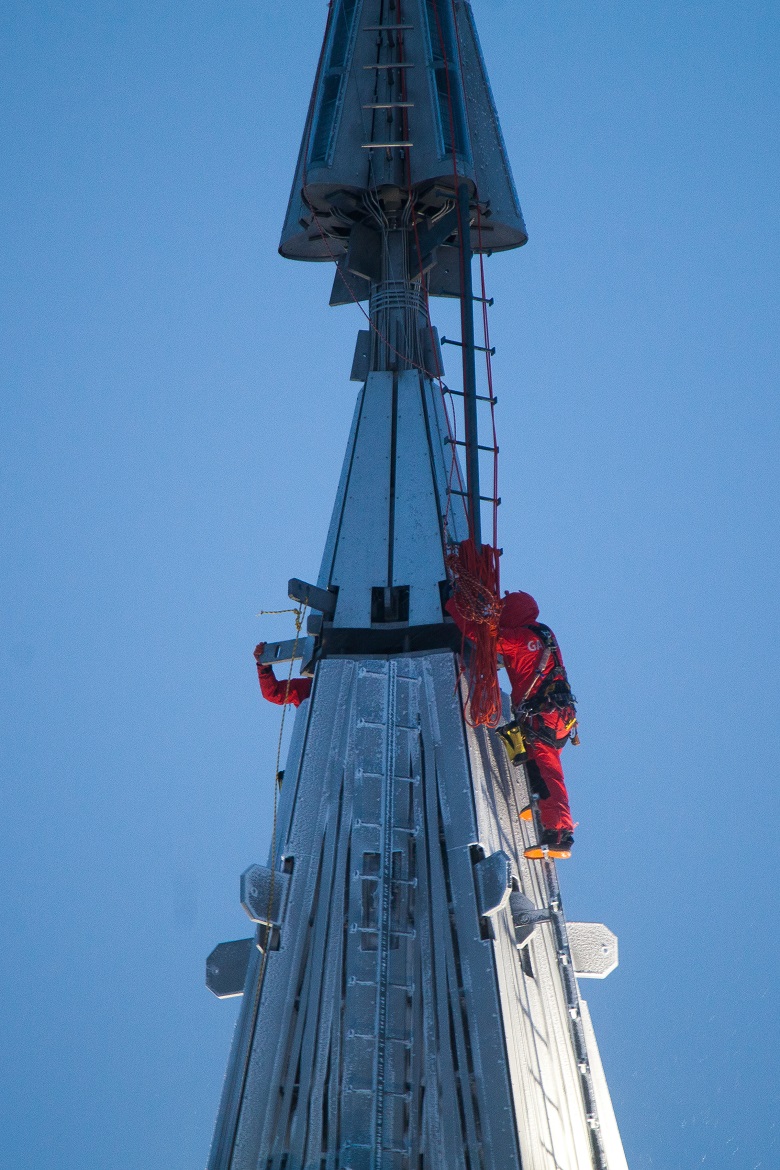
Docked! Here the applause would have been even more appropriate, but only those who are at the height mark see this picture
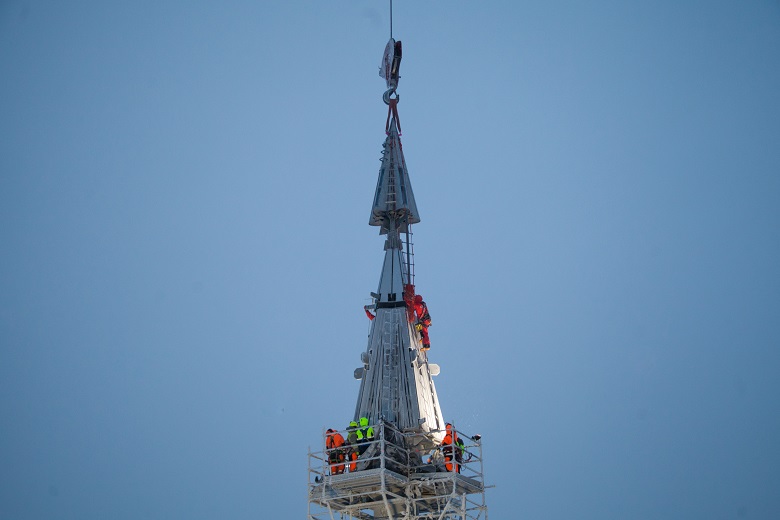
. There is a mounting peak. The second group of climbers works at over 460 meters on the outer wall of the structure!

Work completed. At the peak of the tower lights came on - light markings for aircraft. Now this signal from the earth will always be on.
After installing the peak of the spire, the K-3 crane is immediately lowered to its original position. The super step for which it was designed is made.
***
The construction of the spire is a unique construction operation. But every big deal consists of everyday life. For four months, each builder engaged in the construction of the spire, performed his daily task. Let's look at the construction days of this period.

Everyone who is busy at the installation of the Lakhta Center spire understands this phrase literally: they really need to get up to work. This road - with transfers. Up to 52 floors - on the elevator. Office "shindler" - fast, quiet and smooth - have already begun their labor mileage. Their mission is honorable - they carry those who build a tower, giving the most valuable thing a person has - their work, time, and of course, love for their creation.
Elevator cabins are still covered with protective screens - from accidental damage during construction.
From the 52nd floor, you need to go for a transfer - up to the 81st floor there is a construction elevator, a reliable slug.
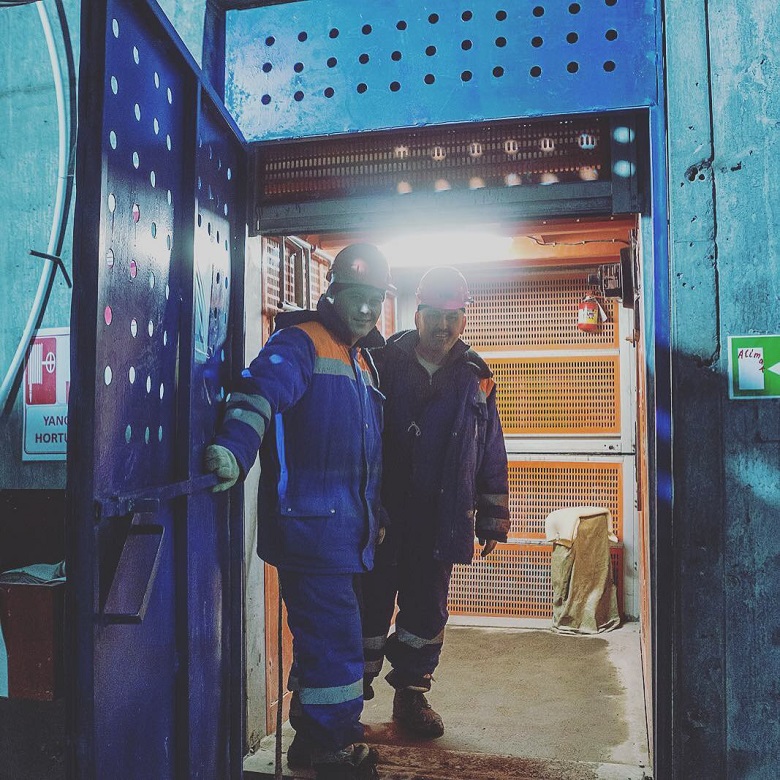
The next leg of the journey is the slowest: on a monolithic staircase, and from the 89 level of the tower - on a lightweight metal staircase in the steeple.

If the construction debt calls even higher, then you are here:
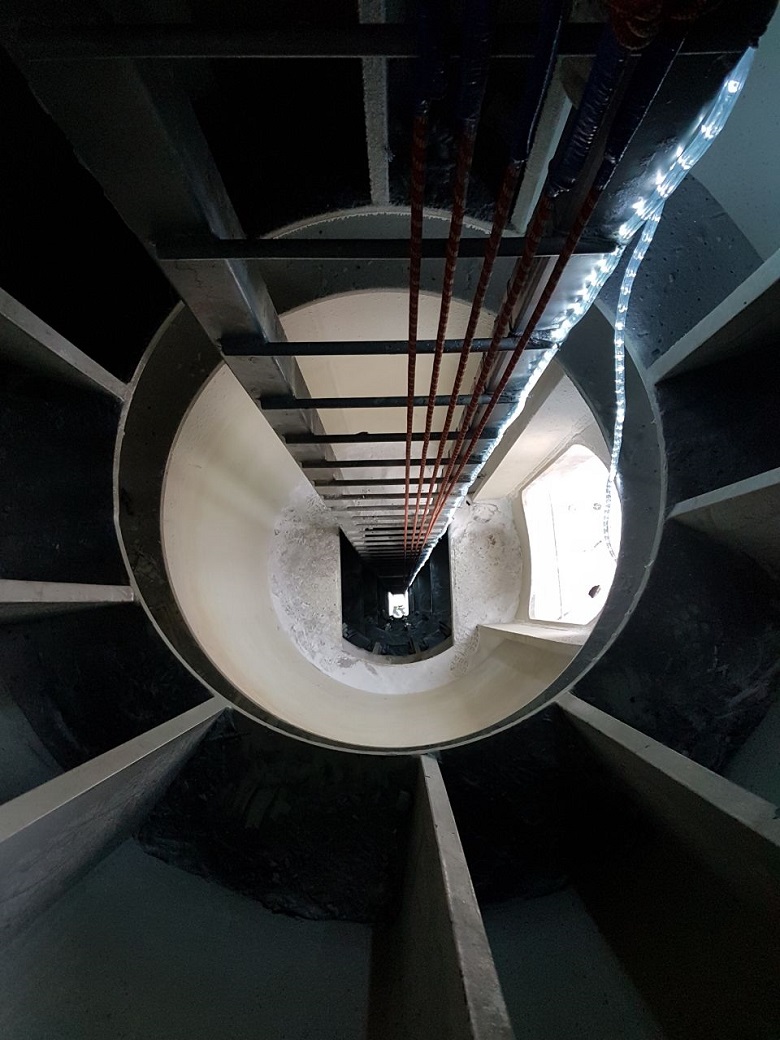
The staircase in the central column of the spire. The
main difficulty of this stretch of path and this area of work is not even height, but space constraint.

But above - absolute and dangerous space.

The final section of the spire - tower peak - in the factory environment.
These nine steps on the outer part of the facade of the 13-meter structural completion of the spire lead to the mark of 462 meters. This section of the climb is only outside and only for industrial climbers.
The entire walk-lift route can take up to 40 minutes. In the near future, visitors to Lakhta Center will reach the 87th floor in 45 seconds.
At the construction site Lakhta Center everything is provided. Only wind is not at the mercy of people
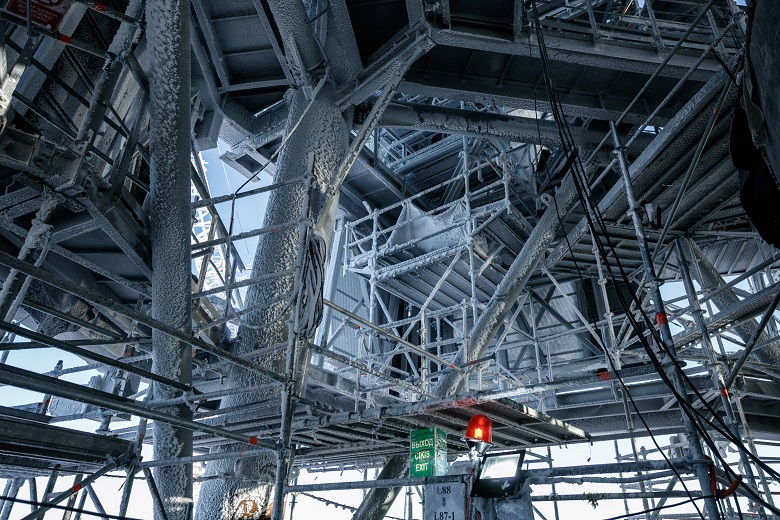
Strong wind expected? All - on the way out. Above the level of 88 there will be no one left.
Construction is going on a tight schedule, but there is a strengthening of the wind - and you just have to wait and then catch up. In total for 2017 there were more than 100 warnings from the Ministry of Emergency Situations about the unfavorable strengthening of the wind in St. Petersburg. This is almost a third of the year. The four-month operation to install the tower spire had 18 days with a strong wind.

Windsock on the tower spire. December 2017 The
wind is the most changeable component of the high-altitude microclimate. The temperature at the top and bottom may vary not so much. But the wind - quite often. In 2017, builders recorded gusts of a force of 141 km / h!

Insulated clothing is required when going upstairs. “Above it is even cold in summer ,” says AECOM’s construction control engineer Alexander Pimakin. In winter equipment includes jackets, pants, balaclava, gloves - all the most insulated, waterproof and windproof. Shoes - on non-slip soles with a metal insole - from accidental damage.
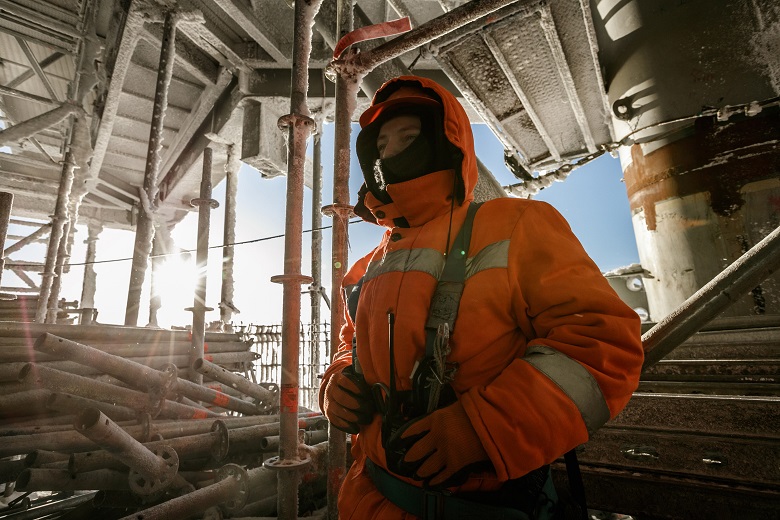
In such equipment it is difficult to distinguish who is who, but only to the uninitiated person. Just as in the army, the branches of the troops differ in color and shape of the uniform, so on the construction site - they can be distinguished from the team of which contractor and which specialty is the builder. Command personnel, engineers - in poisonous-green signal vests and white helmets. In gold - surveyors, in green - labor protection and quality control engineers, in blue - mechanics, gray - foremen, in orange - concrete workers and fixers.
Climbing equipment is a sure sign of a high-altitude builder. For anyone who goes to the open structure - in particular, on the spire, a five-point harness and continuous insurance in two places are obligatory.

But the crane operators, when working in the crane cabin, can be dressed quite easily, despite the awesome snow-white exterior of the cranes.

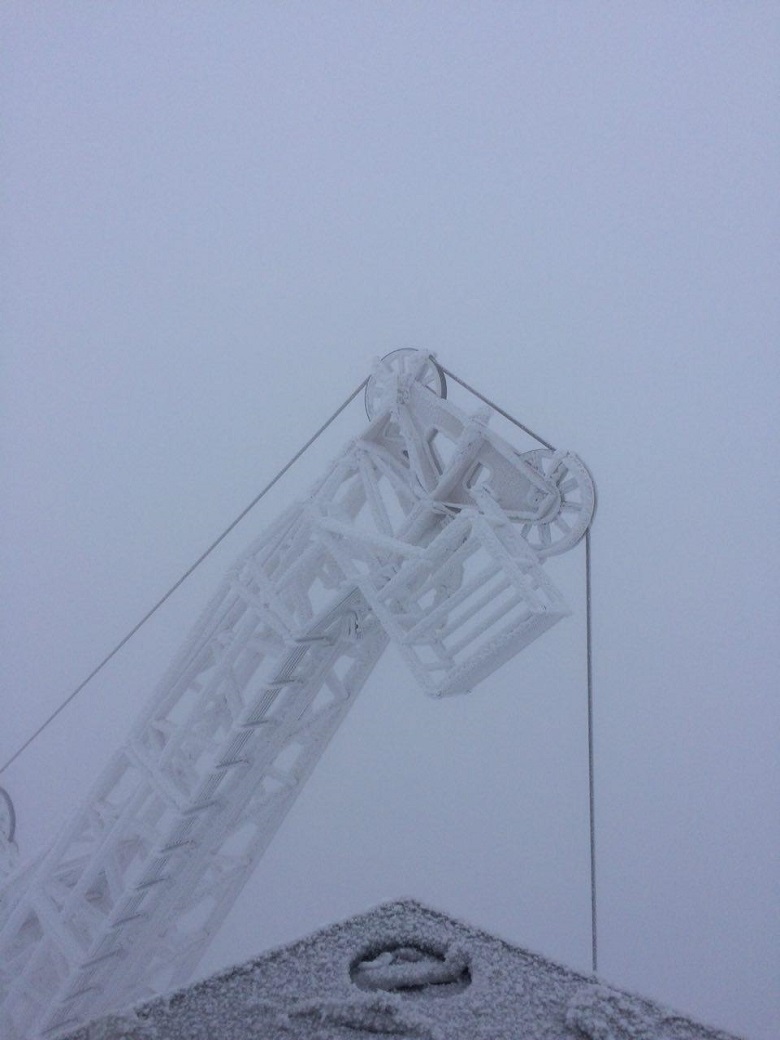
Inside the tower cabin - the stove, the windshield will be cleaned by the “wipers” - everything is just like in a regular car.

But to get up without special clothing is not enough: the last bridge is at 355 meters, then another 90 meters up the metal stairs in the crane tower.

Transition bridges
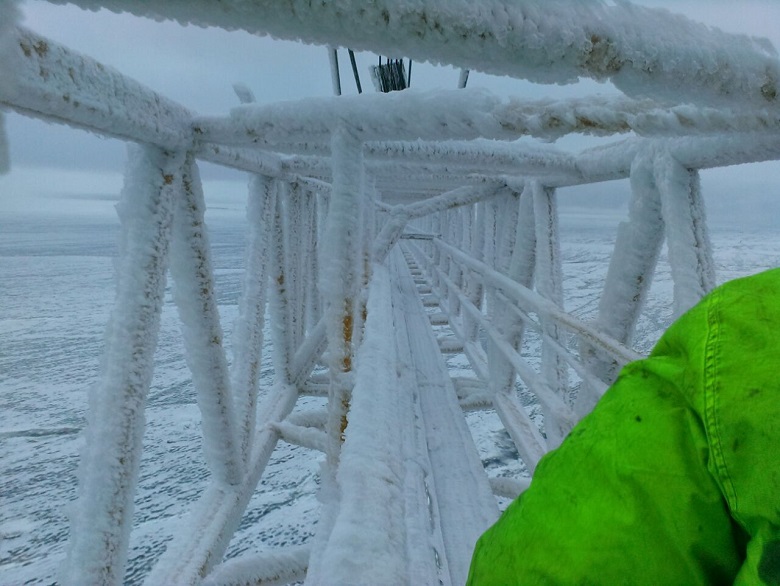
Inside the boom of the crane.
The assembly of metal structures at sub-zero temperatures is a subject of close monitoring. Before climbing to the assembly level, all parts are thoroughly cleaned of snow, ice or dirt.

Installation of scaffolding. January 2018
When assembling monitor the temperature. If the thermometer is below minus five - for some operations, correction factors are introduced or heat levels are set.
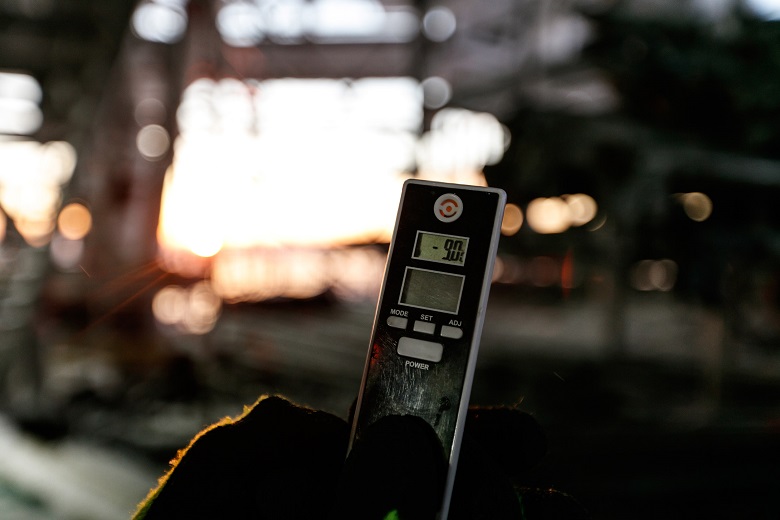
On the steeple of Lakhta Center. Air temperature is minus 9 ° С. January 2018

Spire space in hoarfrost. After mounting the structure is frozen
Winter north day is short. December twilight covers the city already in four days, light day - a little less than six hours. Construction goes around the clock. The area of the spire is no exception, despite its elevation and construction operations in the dark season.
Many people are accustomed to the building lighting of the tower. The electricians of Lakhta Center are in the forefront - temporary power supply lines are quickly pulled to rapidly increasing sections of new levels. Thanks to their work, installers are always with light, the dark season is not a hindrance.

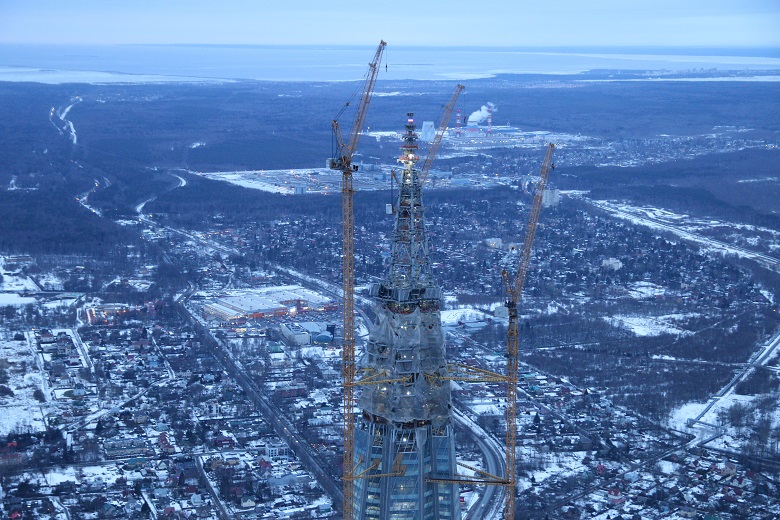
Work on the steeple at dusk. December, 2017
“ Most memorable? The entire amount of metal structures that I assembled in all the previous time of my work - and this is 20 years - including during the construction of shelf platforms - drilling, shipping - is only half of what is here, in Lakhta Center ... And more- once , while climbing up, was in two levels of clouds. On the 30th floor - the first cloud, then - around the 70th floor - the second cloudiness level, and around the 80th - turned out to be above the clouds, like on an airplane when you fly out of the clouds - and there is the sun , ”says Igor Romanenko.

" The construction of Lakhta Center itself - I did not see such complexities and delight in technical performance. The architecture is very complicated, and everything is embodied. Everything is from the metal to concrete works, the facades are top-notch", - says Liebherr service engineer Sergey Prochukhan, - "And yet - sunsets."
“Unique super massive tower constructions. Wonderful sunrises and sunsets, and the city under the clouds " , - share unforgettable Alexander Pimakov from AECOM.







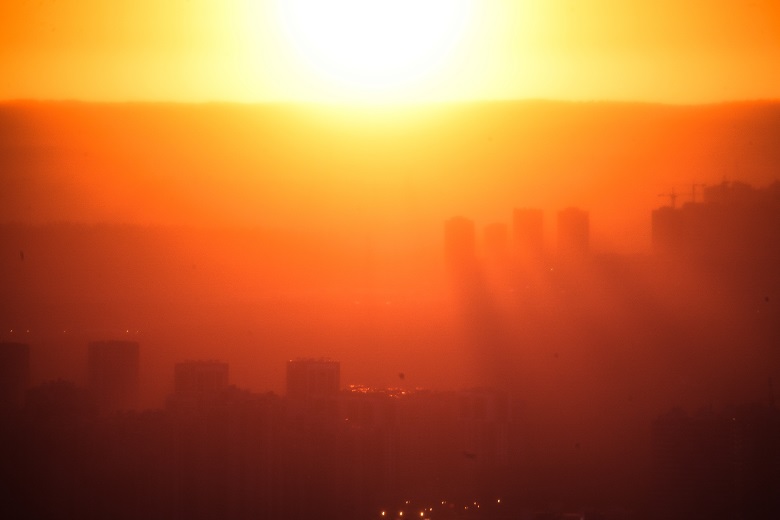
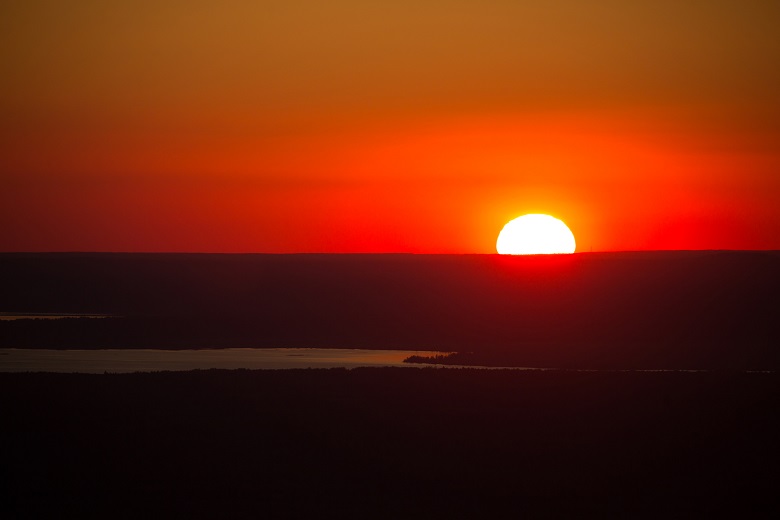
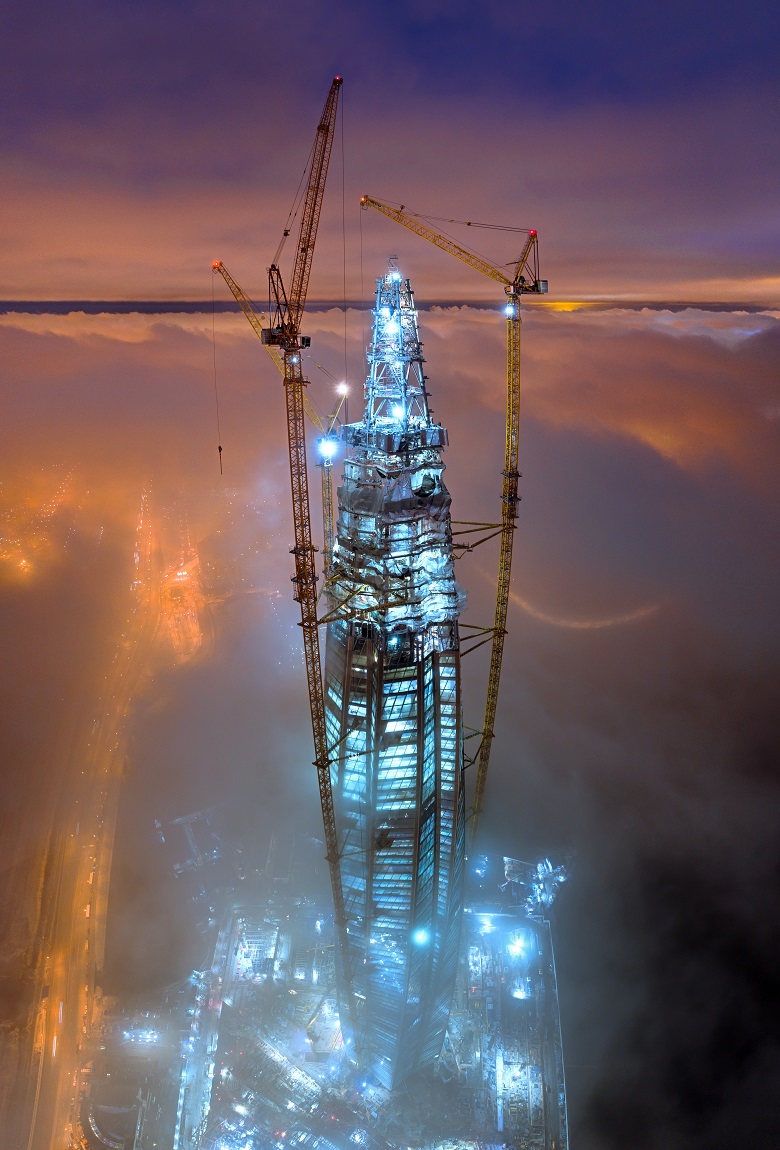
Sunrises and sunsets over the tower of Lakhta Center. Summer 2017- January 2018
***
The first part of the material is here .
***
SHORT DOCUMENTARY VIDEO ABOUT STUD TOWER LACHTA CENTER
***
Thank you for assisting in the preparation of the material by the construction engineer of the customer service of IFC Lakhta Center Igor Romanenko, AECOM building control engineer Alexander Pimakin, Renaissance Construction engineer Rustam Doschanov, Liebherr service engineer Sergey Prochuhan.
Photos of Vyacheslav Korolev (operation on installation of a spire, inside a spire), Nikita Grigoriev (photo from cranes), Ruslan Genk (photo from cranes), Nikolai Gontarya (summer), Ivan Smelov (summer), Igor Romanenko (clouds), Rustam Doschanov ( cranes, a spit mounting operation), Alexander Pimakin (clouds over the city, sunset), Viktor Sukhorukov (final photo).

Installation of the final part of the spire took less than a day. Waiting was delayed for two days. But the preparation ... It started at the dawn of floor-by-floor construction, even before the appearance of giant tower cranes on the shores of the Gulf of Finland.
Crane training
No wonder the powerful lifting machines Lakhta construction. In this painted as on the notes of the building party they played one of the main roles.
By October 2017 around the skyscraper - a trio of "libherry." Crane "K-4", which worked in the center of the core, has already been disassembled: the core ended at level 88.
Lifting trinity - machines based on the model Liebherr 710HC-L 32/64 - the largest crane with a swinging arm, produced by a global manufacturer. But these cranes are not from the mass conveyor. They were created specifically for the construction of Lakhta Center. Crane "K-3" - for the installation of the final part of the spire construct.

“... Liebherr manufactured cranes for a skyscraper on a special project, there were separate calculations, a separate project for these machines, conditions of operation of cranes at peak heights, wind were separately calculated,” says Liebherr service engineer Sergey Prochukhan.
There are two reasons for this: architectural features and microclimatic conditions for the construction of the Lakhta Center tower.
““ The solid monolithic core of the Lakhta Center tower goes up to level 88, above — even more than 100 meters of metal structures. The metal structures of the spire, of course, do not withstand the load from the fixings of cranes, therefore the cranes are fixed at the highest possible height - 355 meters, ”says Rustam Doschanov, Renaissance Construction engineer.
The spire of the tower is steel half-timbered in a metallized shell. Bearing meter pipes-racks and a mass of 2000 tons - inspire, but just for now you do not undertake to compare the scale of the rest of the Supertoll. Each crane attached to the supermassive core of the tower gives a load of 240 tons to the structure! Elastic and light structure of the spire can not cope with this.

The second important point is the wind. The standard limit for crane operation is 15 m / s. For heights of mass construction, such gusts of wind are not a frequent occurrence, it is possible to build. On the skyscrapers marks - and the wind to match ...
“At altitudes of 300–400 meters, the wind speed was often 120 km / h, the wind record was 141 km / h!”, Rustam Doschanov says.
Not surprisingly, the construction in Lakhta has become a real challenge for the manufacturer of lifting equipment. Cranes were designed special - such that they will safely stand even with very strong wind and reach the spire mark.

The last crane attachment to the core of Lakhta Center is at 355 meters.
After this pristezhka at the cranes begins part of the tower, free-standing, composed of reinforced sections. Due to technical solutions, it was possible to resolve the issue with the winds. Estimated wind speed for giant Lakhta cranes - 164 km / h! The highest level of assessment of wind speed on the Beaufort scale! Of course, it is impossible to work with such a hurricane - but the towers will safely stand under the blow of a similar element.
About helicopters
Why did the installation of the top-end design not be carried out with the help of helicopter technology, for example, as when installing a new antenna on a Petersburg TV tower?
Installation of the antenna on the St. Petersburg TV tower, 2011. Installation is carried out with the help of a Mi-8 helicopter with a high-class crew. Photo source
Rustam Doschanov, engineer at Renaissance Construction: “This option was also considered as an alternative. The mass of the top of the spire is 8 and 13 tons. The most optimal weight of the structure for mounting a helicopter is 5 tons: a helicopter with a carrying capacity of 5 tons is most stable in the air. We considered the proposal of the helicopter company, which has a helicopter with a carrying capacity of 20 tons. It is difficult to mount such a large helicopter - it is not stable in the air, it is difficult for installers to fix structures. And our cranes have a frequency converter that allows you to smoothly raise and lower structures to the nearest millimeter. "
Sergey Prochukhan, Liebherr service engineer: “Compared to the helicopter, the crane provides very accurate positioning of the cargo. The helicopter installation case is a determining, crucial factor - the skill of the pilot and installer. At installation by the crane influence of a human factor is much less. The crane provides an opportunity to file very carefully and safely for installers. ”
By the end of January, the position of the “senior” libkher, the K-3 lifting machine, approached 450 meters in jib. Ahead is the main challenge, the one for which K-3 was designed even before the start of floor-by-floor construction.
But back to the spire.
Lahta Center Peak
The builders assembled most of the tower's spire on the object from steel pipes and connecting beams. The story of the final design is different: she arrived in Lakhta from the factory almost ready-made.

The top design of the spire - tower peak - is a cone of three horizontally separated elements. On the bottom will install later SOF and facade. The tops are already delivered fully assembled: a frame in a stainless steel shell, with straight edges on the outside corners. To the peak of a cone, the faces that run from the bottom of a skyscraper and continue in the architecture of its spire converge at one point. The Lakhta Center Tower twists from the bottom to the top 90 degrees and opens up at this end.

Training
From the report of the manufacturer, Gartner:
"(Cone of the pinnacle of the spire - approx) ... was made of stainless steel sheets up to 8 cm thick in Gundelfingen with the involvement of mechanics specializing in Goppingen stainless steel products. These shaped sheets were treated with a laser and a water jet and then welded and bolted to create a complex structure. "
Production of construction at the factory in December 2017-January 2018:

Welding of stainless steel. Upper part of the structural frame Structural

frame

Preparing the structural frame base
Ten holes - for future connection with a supporting ring beam mounted on the central column-tower in the tower at 449 meters.

The base of the peak is the attachment points of the upper and lower parts of the structure. The
finished structure is sent to St. Petersburg, to the Lakhta Center construction site ^


Meanwhile, at the Lakhta Center ... January 2018

The tower peak's future installation site is the central column in the spire of the Lakhta Center tower, 449 meters

The builder applies fire retardant and paintwork on the supporting ring beam, which subsequently connects the central column in the spire and its peak. Ground operation
The final design of the spire arrives at the construction site
. Everything is ready for the final. But until the triumphant moment will pass two more days.
Expectation
“The most difficult thing at this stage is to wait for the weather. Now everything is ready - you have to wait for the window. When the wind will be steadily low so that the cranes and people can work, ”says Igor Romanenko, construction control engineer at Lakhta Center, on the eve of the installation of top construction.
Builders really need a couple of serene days to bring the crane to the mark, and people - to the peak of the spire. And now - a good forecast: January 28 and 29 - time for high achievements.
Installation

Preparing the K3 crane
By the end of January 2018, the giant Libher has already left behind all European supercranes. The bravest London crane operator, who mounted the peak on the Shard skyscraper, and the brave guys who managed to lift the final designs of the towers of Moscow-City - were not at such elevations.
But ahead is the main step up. Right before installation of the final design, the K-3 crane is additionally increased: plus three sections of 5.8 m each and one of 2.85 m stand at the base of its metal tower. The height of the goose-467.3 m! This super step is possible only for a short time - stability with a wind below 100 km / h and work with a wind of no more than 50 km / h.

Superstep crane "K3" The

lower part - the base of the cone spire - in readiness

At the start

First go! Lifting to the installation level at the mark of 449-450 meters. An

annular beam, on which will fix the base of the final design.
After installation, the lower part constructive structure will be surrounded by the facade and complemented by lighting. In the meantime, the task of installers is to quickly install and prepare to receive the peak of the spire.
Early morning January 29, 2018
On the ground


Last design check before sending to the assembly level and installing fixing cables for crane lifting

Still on the ground at the top of the spire are installed lights of light marking, architectural lighting and anti-icing system (heated). Checking all systems


Sling cargo on a crane hook

Lifting gone! Gap - to the applause of the builders

Climb

One second before escaping from the ground from the ground.
Docking process:


Notice how gently and precisely the crane lowers the load to the mark. This is extremely important for the safety of climbers - in the case of a helicopter, the buildup of a load and a strong outflow to the installers from under the aircraft blades would be inevitable.

The length of the crane cable is almost half a kilometer!


Docked! Here the applause would have been even more appropriate, but only those who are at the height mark see this picture

. There is a mounting peak. The second group of climbers works at over 460 meters on the outer wall of the structure!

Work completed. At the peak of the tower lights came on - light markings for aircraft. Now this signal from the earth will always be on.
After installing the peak of the spire, the K-3 crane is immediately lowered to its original position. The super step for which it was designed is made.
Rustam Doschanov, Renaissance Construction Engineer: “Installation is complete - this is a confirmation that we did everything correctly. Everything is calculated, checked and rechecked. But some risks still always exist. Only when the case is finished, we can definitely sum up: we did everything right. ”
***
BEAUTY OF HIGH WISDAY
The construction of the spire is a unique construction operation. But every big deal consists of everyday life. For four months, each builder engaged in the construction of the spire, performed his daily task. Let's look at the construction days of this period.

To work - the rise!
Everyone who is busy at the installation of the Lakhta Center spire understands this phrase literally: they really need to get up to work. This road - with transfers. Up to 52 floors - on the elevator. Office "shindler" - fast, quiet and smooth - have already begun their labor mileage. Their mission is honorable - they carry those who build a tower, giving the most valuable thing a person has - their work, time, and of course, love for their creation.
Elevator cabins are still covered with protective screens - from accidental damage during construction.
From the 52nd floor, you need to go for a transfer - up to the 81st floor there is a construction elevator, a reliable slug.

The next leg of the journey is the slowest: on a monolithic staircase, and from the 89 level of the tower - on a lightweight metal staircase in the steeple.

If the construction debt calls even higher, then you are here:

The staircase in the central column of the spire. The
main difficulty of this stretch of path and this area of work is not even height, but space constraint.

But above - absolute and dangerous space.

The final section of the spire - tower peak - in the factory environment.
These nine steps on the outer part of the facade of the 13-meter structural completion of the spire lead to the mark of 462 meters. This section of the climb is only outside and only for industrial climbers.
The entire walk-lift route can take up to 40 minutes. In the near future, visitors to Lakhta Center will reach the 87th floor in 45 seconds.
In Petersburg - the wind
At the construction site Lakhta Center everything is provided. Only wind is not at the mercy of people
“To work on the steeple, the wind must be below 15 m / s in order for the cranes to be able to work ... People in open structures of the spire are also not allowed in bad weather conditions - there is an inspector on the 88th floor who controls coming to higher levels: checks qualification, tolerance, availability of PPE and weather conditions, ”says Igor Romanenko, construction engineer of Lakhta Center.

Strong wind expected? All - on the way out. Above the level of 88 there will be no one left.
Construction is going on a tight schedule, but there is a strengthening of the wind - and you just have to wait and then catch up. In total for 2017 there were more than 100 warnings from the Ministry of Emergency Situations about the unfavorable strengthening of the wind in St. Petersburg. This is almost a third of the year. The four-month operation to install the tower spire had 18 days with a strong wind.

Windsock on the tower spire. December 2017 The
wind is the most changeable component of the high-altitude microclimate. The temperature at the top and bottom may vary not so much. But the wind - quite often. In 2017, builders recorded gusts of a force of 141 km / h!
Snow and frost

Insulated clothing is required when going upstairs. “Above it is even cold in summer ,” says AECOM’s construction control engineer Alexander Pimakin. In winter equipment includes jackets, pants, balaclava, gloves - all the most insulated, waterproof and windproof. Shoes - on non-slip soles with a metal insole - from accidental damage.

In such equipment it is difficult to distinguish who is who, but only to the uninitiated person. Just as in the army, the branches of the troops differ in color and shape of the uniform, so on the construction site - they can be distinguished from the team of which contractor and which specialty is the builder. Command personnel, engineers - in poisonous-green signal vests and white helmets. In gold - surveyors, in green - labor protection and quality control engineers, in blue - mechanics, gray - foremen, in orange - concrete workers and fixers.
Climbing equipment is a sure sign of a high-altitude builder. For anyone who goes to the open structure - in particular, on the spire, a five-point harness and continuous insurance in two places are obligatory.

But the crane operators, when working in the crane cabin, can be dressed quite easily, despite the awesome snow-white exterior of the cranes.


Inside the tower cabin - the stove, the windshield will be cleaned by the “wipers” - everything is just like in a regular car.

But to get up without special clothing is not enough: the last bridge is at 355 meters, then another 90 meters up the metal stairs in the crane tower.

Transition bridges

Inside the boom of the crane.
The assembly of metal structures at sub-zero temperatures is a subject of close monitoring. Before climbing to the assembly level, all parts are thoroughly cleaned of snow, ice or dirt.

Installation of scaffolding. January 2018
When assembling monitor the temperature. If the thermometer is below minus five - for some operations, correction factors are introduced or heat levels are set.

On the steeple of Lakhta Center. Air temperature is minus 9 ° С. January 2018

Spire space in hoarfrost. After mounting the structure is frozen
In the dark night
Winter north day is short. December twilight covers the city already in four days, light day - a little less than six hours. Construction goes around the clock. The area of the spire is no exception, despite its elevation and construction operations in the dark season.
Many people are accustomed to the building lighting of the tower. The electricians of Lakhta Center are in the forefront - temporary power supply lines are quickly pulled to rapidly increasing sections of new levels. Thanks to their work, installers are always with light, the dark season is not a hindrance.


Work on the steeple at dusk. December, 2017
Unforgettable
“ Most memorable? The entire amount of metal structures that I assembled in all the previous time of my work - and this is 20 years - including during the construction of shelf platforms - drilling, shipping - is only half of what is here, in Lakhta Center ... And more- once , while climbing up, was in two levels of clouds. On the 30th floor - the first cloud, then - around the 70th floor - the second cloudiness level, and around the 80th - turned out to be above the clouds, like on an airplane when you fly out of the clouds - and there is the sun , ”says Igor Romanenko.

" The construction of Lakhta Center itself - I did not see such complexities and delight in technical performance. The architecture is very complicated, and everything is embodied. Everything is from the metal to concrete works, the facades are top-notch", - says Liebherr service engineer Sergey Prochukhan, - "And yet - sunsets."
“Unique super massive tower constructions. Wonderful sunrises and sunsets, and the city under the clouds " , - share unforgettable Alexander Pimakov from AECOM.










Sunrises and sunsets over the tower of Lakhta Center. Summer 2017- January 2018
***
The first part of the material is here .
***
SHORT DOCUMENTARY VIDEO ABOUT STUD TOWER LACHTA CENTER
***
Thank you for assisting in the preparation of the material by the construction engineer of the customer service of IFC Lakhta Center Igor Romanenko, AECOM building control engineer Alexander Pimakin, Renaissance Construction engineer Rustam Doschanov, Liebherr service engineer Sergey Prochuhan.
Photos of Vyacheslav Korolev (operation on installation of a spire, inside a spire), Nikita Grigoriev (photo from cranes), Ruslan Genk (photo from cranes), Nikolai Gontarya (summer), Ivan Smelov (summer), Igor Romanenko (clouds), Rustam Doschanov ( cranes, a spit mounting operation), Alexander Pimakin (clouds over the city, sunset), Viktor Sukhorukov (final photo).

